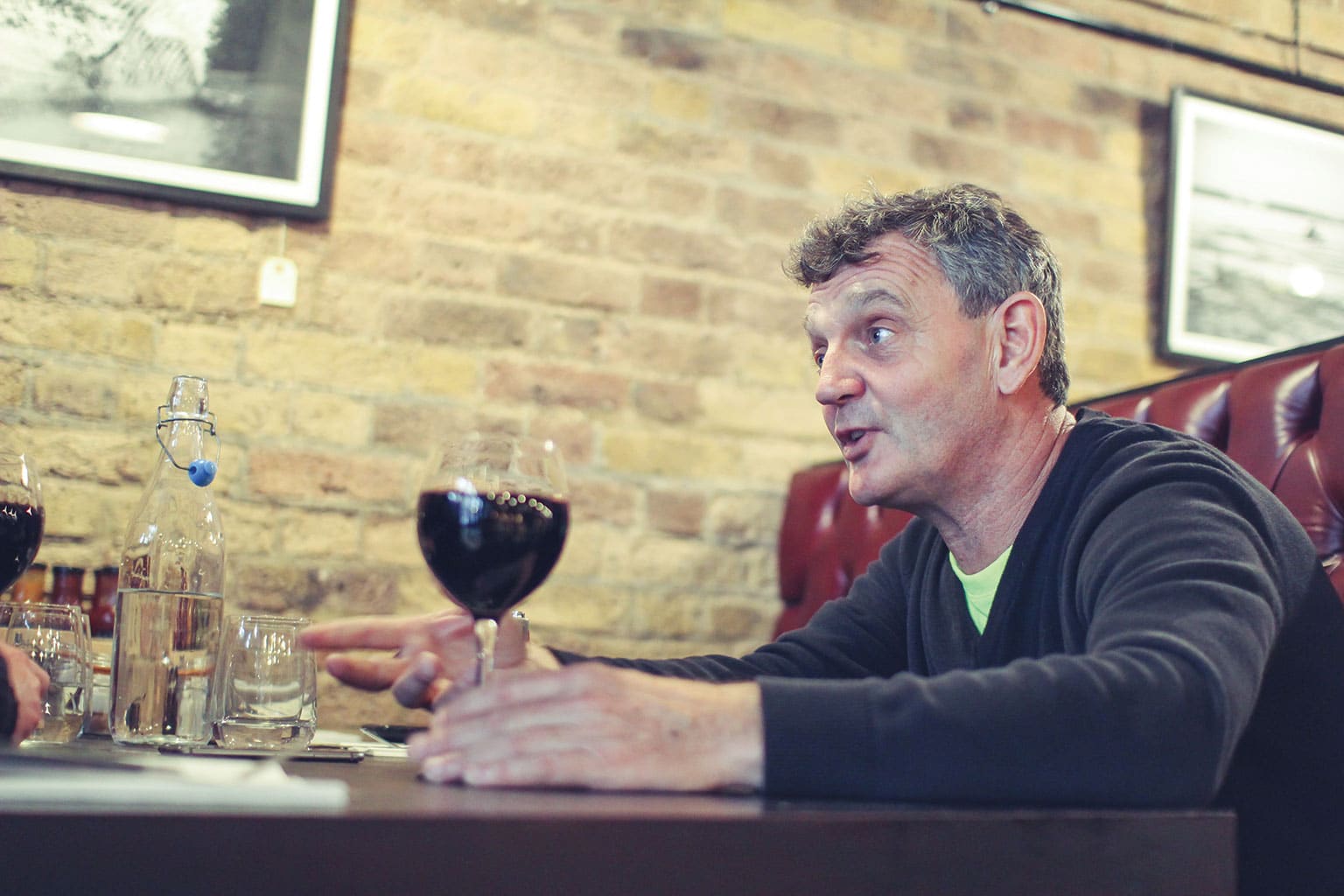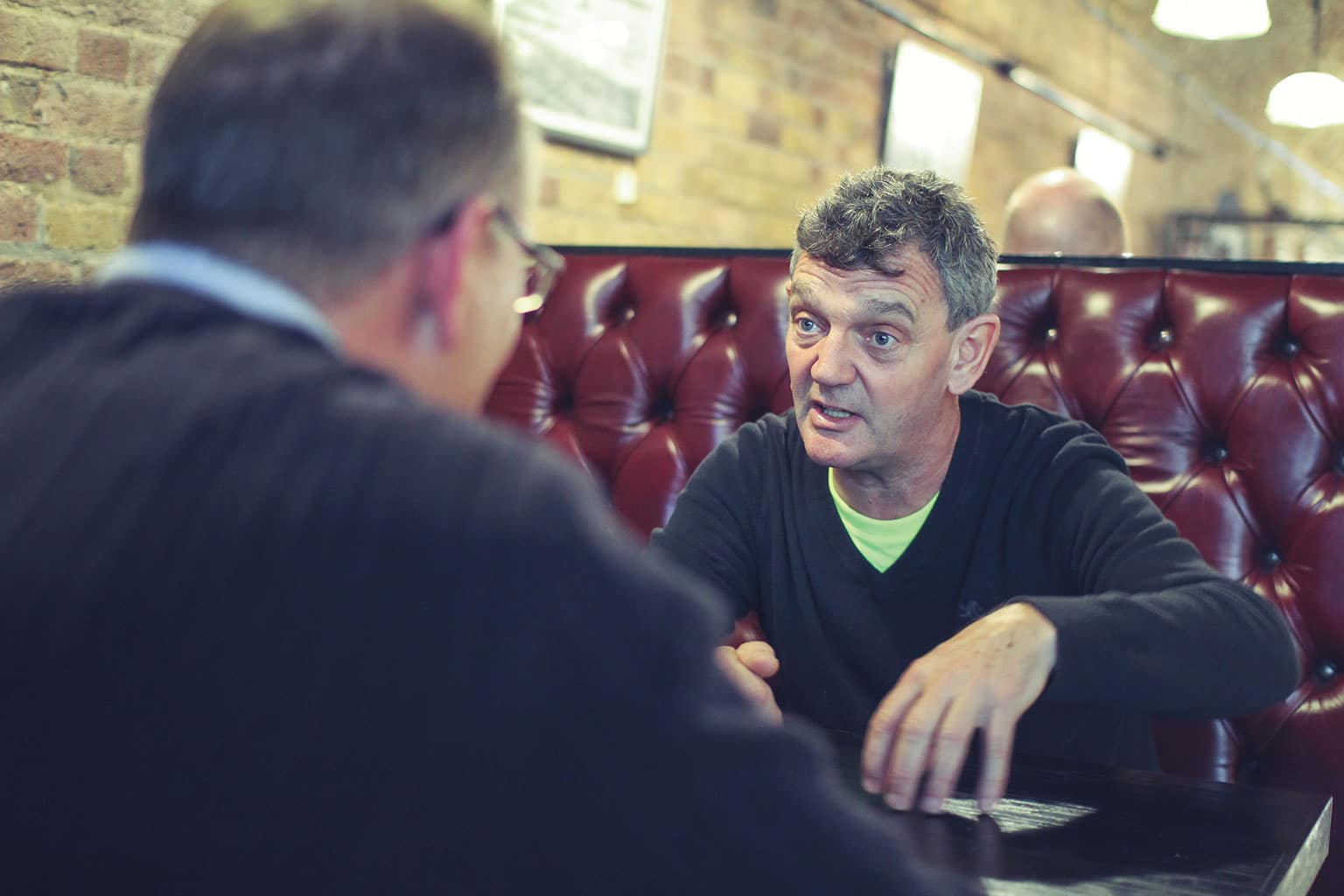Lunch with... Tommy Byrne
Rising from nowhere to Formula 1 in the blink of an eye, he had the potential to become one of motor sport's all-time greats. But...
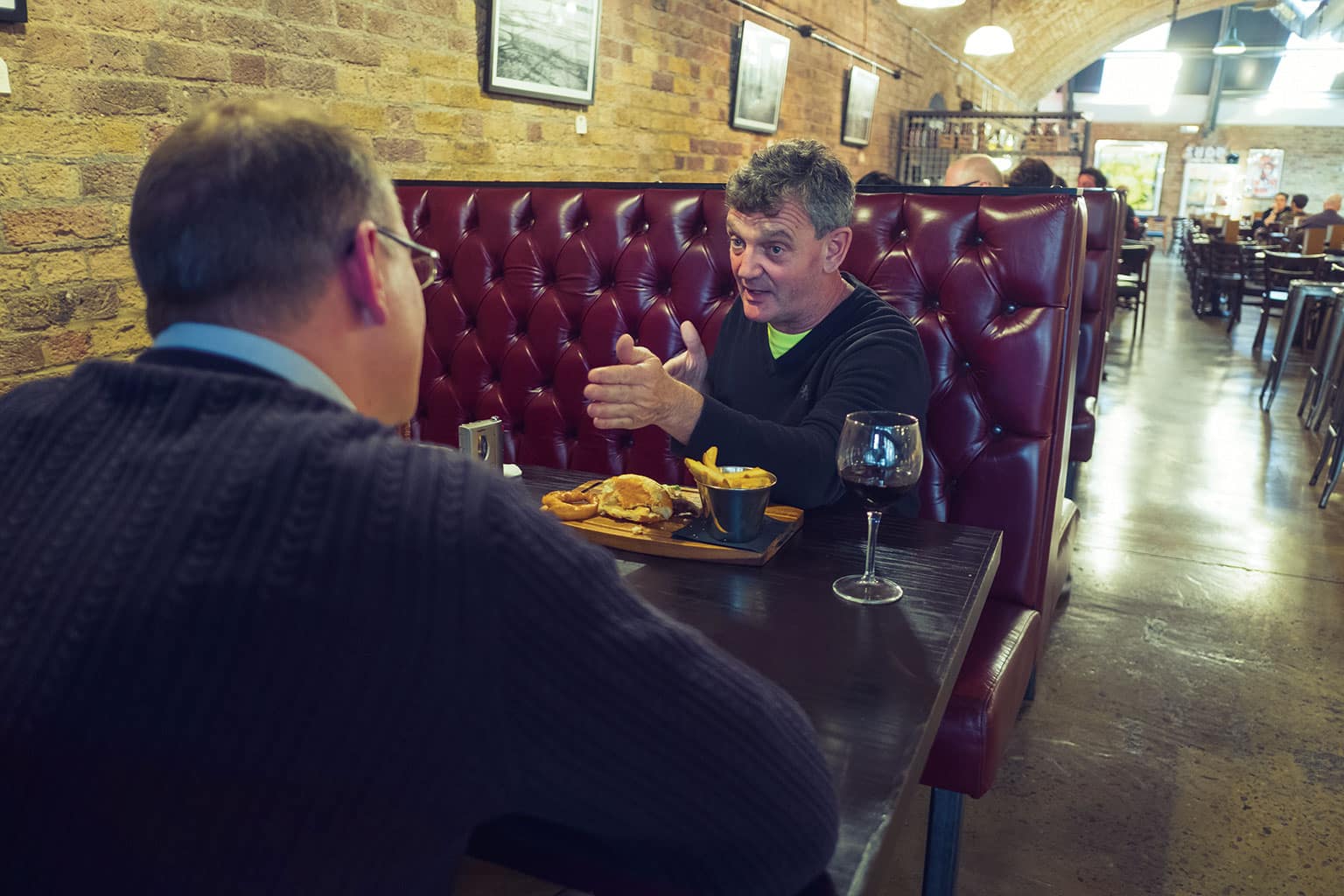
Lyndon McNeil
Tommy Byrne, retired racing driver and reformed hell-raiser asks the waitress what the soup of the day is.
“Carrot and fresh coriander,” she says.
“I’ll have the burger and fries,” he replies. “And a glass of red wine. Large. You choose.” The waitress opts for a Malbec.
We are in a fashionable bar/restaurant called the Bike Shed in Shoreditch, east London. The walls are all exposed brick and retro neon signs complete with a display of polished café racers to give it an authentic dive bar feel.
Byrne, born in Northern Ireland but living in Florida, is unconvinced. “I’m a dive bar guy,” he says. “I love them. In America we call them biker bars. They are a little different to this.”
We are here to talk about a new film, based on his scarcely believable life, called Crash and Burn. It tells the tale of a small-town Irish boy from a dirt-poor family of eight, who went from racing Minis around a farmer’s field to competing in Formula 1 within a few years. It speaks to team managers and journalists who remember the boy who was so blisteringly fast and fearless that comparisons with his contemporary Ayrton Senna are not just plausible but underplay his talent.
It also documents how Byrne blew it all in a whirlwind of wild partying and a stubborn refusal to play the F1 game.
Byrne, 58, doesn’t quite see it that way. “It’s not that simple,” he says. “I still find the film hard to watch. If you watched it you’d think I was still f**ked, but I’m not, I’m doing great. Ever since I left Mexico I’ve been fine.”
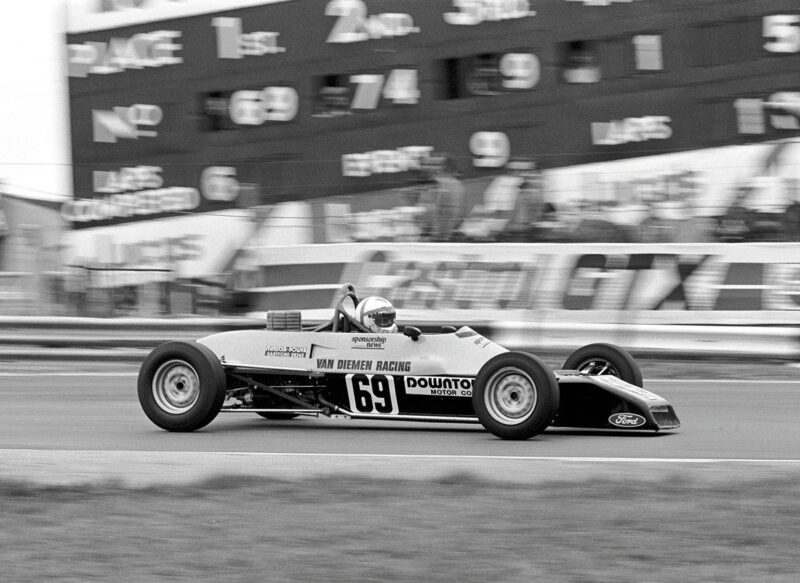
After dominating in FF2000, Byrne stepped back to FF1600 and won the 1981 Formula Ford Festival
Motorsport Images/Sutton
So, let’s start with Mexico. It represents the end of Byrne’s racing life – and its nadir. He arrived there in 1993 to drive in a domestic Formula 3 series after a period competing in second-tier American racing. His brilliant career in Europe, so full of early promise, which had seen him win two British FF1600 titles, the British and European 2000 championships, the British F3 Championship and compete in Formula 1 for five races, had been left in tatters a decade previously – and he was now in the market to make some money.
“In Mexico City I was a mini superstar again,” he says. “They would have 40,000 people at an F3 race. I’d struck a deal by which they paid me $2000 in cash per race, plus expenses, plus a full mini bar. I was earning a lot of money and there was a lot of partying. I could pick the phone up in Mexico City at lunchtime and then party until 4am the next morning. There were plenty of women around and everyone loved their vodka and cokes. They were wild times.
“But it was all coming to an end… and it all came together one night when a team-mate lost his mind and came out of his hotel room with a girl and a gun. I came out of my room and said ‘What are you doing?’ And he shot at me – a bullet went over my head. I got out of there, went to my team manager and said ‘This guy’s lost his mind, he’s gonna kill someone – or kill himself,’ and I quit the team.
“That was it. That was the end of my racing. I realised I was 38 years of age and I wasn’t going anywhere except partying all the time, and I thought I can’t go on like this. That’s when I decided to get a proper job.”
* * *
If anyone was born to drive it is probably Tommy Byrne. He came into this world in the back of a speeding car on Tullysteg Hill in Northern Ireland. “Everyone has a story about where they start off and that is mine,” he says. “The strange thing is that years later that is the hill where all the kids came to test the top speed of their car because it was so long. So, that’s where I was born.”
His mother worked in a local hotel and he had five brothers and sisters. “I was a brat. As a little baby I remember I wanted a Chopper bike and I got it. My sister still brings it up now, no one else got a Chopper bike.”
At the age of eight he started working on a local farm, which he says he did because it enabled him to drive the tractor. His first car was a Fiat 600, which he drove around the field until it broke, then a Hillman Minx. That wouldn’t go forwards because the clutch was slipping, forcing him to drive it backwards around the field until it, too, fell apart.
“That’s when I started to get into racing as a mechanic with a friend, Tony Sharkey. We went down to southern Ireland with the rednecks to go stock car racing. At that time the troubles were on so we had to be careful, it was scarier than anything in F1. And that’s when I got to do my first race. At one meeting Tony crashed the Mini and broke his collarbone. So I was up for driving.
“I remember I made it to pole and I heard the guys behind me, super-fast guys, I heard their engines and I thought now is my chance, this is the big one, a proper car and fast drivers. I was crapping myself. They all went past me and I remember I could hardly steer the car – it had a limited slip diff and 13-inch wheels to get the Torino tyres on to get the right gear ratio. It was pulling the steering wheel out of my hand every time I hit the gas.
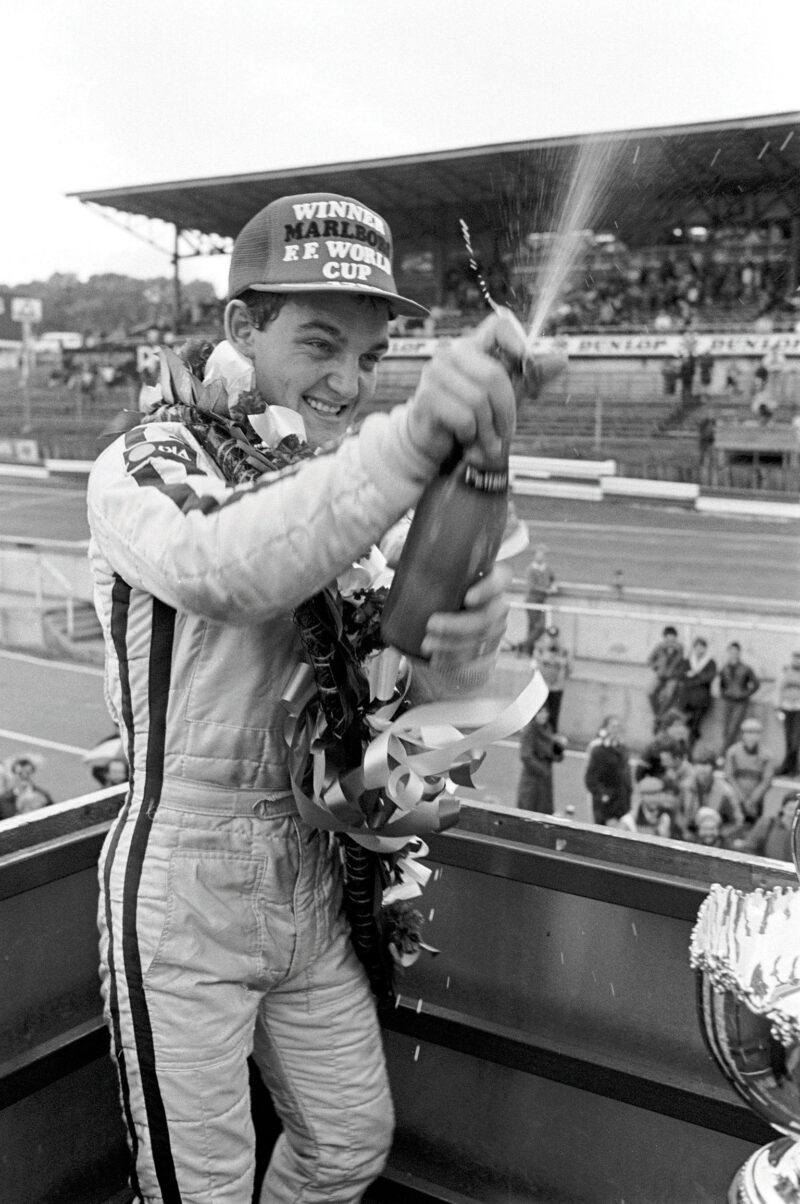
Byrne’s FFord Festival win came in what was usually Ayrton Senna’s Van Diemen
Motorsport Images/Sutton
“Once they all got past me I then settled down. I loved it going past the grandstands. Imagine what that was like. It was very hard to be a mechanic after that. I think I finished fourth in that one.”
By the age of 16 Byrne was working at a local garage and remembers watching the film Grand Prix, starring James Garner, and was blown away by the glamour of Formula 1. “A couple of days later, there was a Formula Ford on a trailer outside the hotel where my mum worked; it was on its way from Northern Ireland to Mondello Park. I sat in it and it felt good.
“I told a friend about it and he said he’d gone through racing school at Mondello Park – 25 laps for 25 punts. That’s how I heard about the John Murphy racing school. I said ‘Did they ask for a licence or anything?’ and he said ‘No’, so
I signed up.
“I remember they said you can’t go over 6000 revs, and there was a tell-tale on the car so if went past 6000 it would stick there and you wouldn’t be allowed back out. After working in the garage I knew this so every time I spun – and I spun nine times – I put my hand behind the dash and reset it. After that I knew what I was going to do. And I knew I needed my own car. I knew I was a fantastic driver. Better than anyone else. I don’t know where that confidence came from, but it was there.”
He persuaded his mum to borrow £2500 against the house to buy a PRS Formula Ford 1600 – “it looked sort of like the one I had sat in” – and went racing at Mondello Park
and Kirkstown. “I crashed on the first day. I had no idea how to overtake – I thought as long as you go down the inside and then hit the brakes later than the other guy you should be OK. But then of course you lock up and the tyres smoke. The more smoke came off your tyres, the better I thought you were doing.
“But sometimes it is better not knowing anything and, even though I was raw. people were talking about me. Years later, I heard that Gary Anderson [who went on to work for Jordan F1], said ‘I’ve seen a guy today taking lines that I’ve never seen anyone take before’.”
Byrne competed in Formula Ford around Ireland and in 1977 managed to get over to England to compete in the Formula Ford Festival. His break came when Bernard Devaney, a fellow Irish racer, moved up to Formula 3. Devaney put Byrne’s name forward to Vic Holman, the owner of PRS, who took the youngster on. At the end of 1978 at the age of 20, Byrne was a works driver with PRS, competing in England and being paid £25 a week. It was, he says, taking another sip of Malbec, “completely unbelievable”.
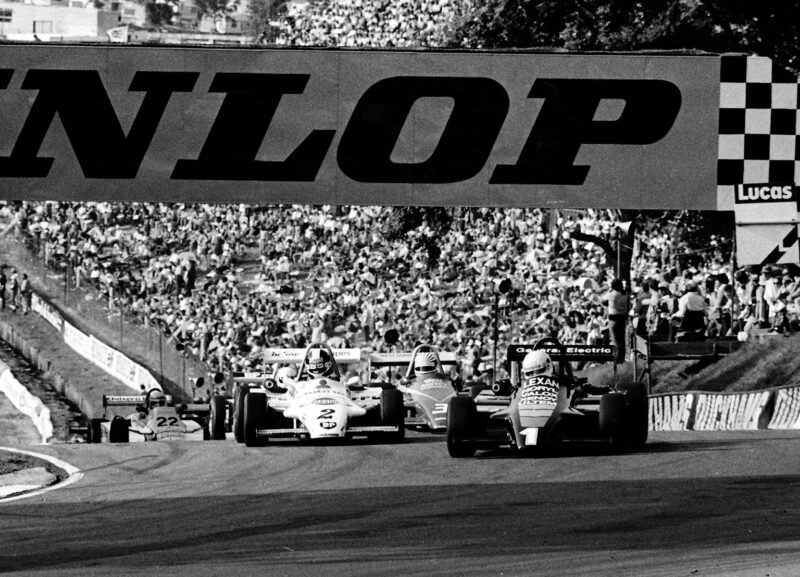
After a poor run of results, Byrne got his Formula 3 challenge back on track at Brands Hatch, with victory in the 1982 British GP support race
Motorsport Images
“I call it the buzz. You either have it or you don’t. The buzz is about more than being fast, it’s about looking fast too. It’s about making an impression, driving on the edge. Max Verstappen has the buzz. In Brazil he found the wide line, we all know about the wide line. But all the others were just driving in the middle of the road because their engineers told them to. Everyone apart from Max. Hans Stuck, he had the buzz. I was there in 1979 at the Nürburgring and the fans all heard his car and this whispering chant went around: ‘Stuckie, Stuckie…’ He had the buzz. And I had it, too.”
Byrne wasn’t the first driver from Ireland to come to race in England. Michael Roe, Derek Daly, Eddie Jordan and David Kennedy had all come before. But he was arguably the most exciting. The problem was that the PRS was
not particularly competitive.
“I knew pretty quickly I didn’t have the best car. I had no patience, I had to win immediately. I had to have the biggest buzz. I had to be better than everyone else and the Van Diemens and Royales were quicker than me.
“I was still learning my craft. Let’s say I did 40 races. I probably crashed 15 times. The car wasn’t good enough, though. I couldn’t go flat out through Russell Bend at Snetterton. Everyone else could. The team would say ‘Tommy you just need some experience.’ But it was the car.”
Showing the abrasiveness that would become his hallmark, he abruptly left PRS before the end of season, signed to drive a Royale before joining the Van Diemen team under Ralph Firman for 1980. “Looking back, the PRS team were really nice guys, and I feel really bad about being a dick to them. When you tell the engineer that the car isn’t good enough for you, that’s being a dick – and I was living with the engineer. They would say ‘have patience’, but when you are 20 you can’t have patience. So I quit. I left the team with nothing, not a dime.
“Ralph Firman was happy because I was the one he was worried about. He always wanted the best guys in his cars, because if you win you sell 60 or 70 of them. Ralph already had Roberto Moreno signed up and Raul Boesel as a pay driver, but he gave me a free car and I could work out of his shop.”
Between them, the drivers set about campaigning for the Formula Ford 1600 titles. Byrne focused on the P&O series, Moreno on the TT and Boesel on the RAC.
“There were times when Roberto and I would come together and we’d know he would need to beat me or I would need to beat him but we helped each other. I helped him win the European Formula Ford Championship in Hockenheim – I ran the other guy off the road. He helped me against Boesel at Snetterton for me to win the British title. That’s teamwork. I won that championship by one point and Boesel hated Moreno for the rest of his life. It was dog-eat-dog racing.”
Byrne won the 1980 P&O and RAC FF1600 titles, with a total of 11 wins – two more than Moreno, four more than Boesel – from 22 starts. To put that in perspective it is worth comparing his record with that of Ayrton Senna, who joined Van Diemen the following year. Senna’s 1981 season is often recalled as one of dominance, yet he took only one more victory than Byrne had in 1980 – from more starts and against arguably lesser opposition.
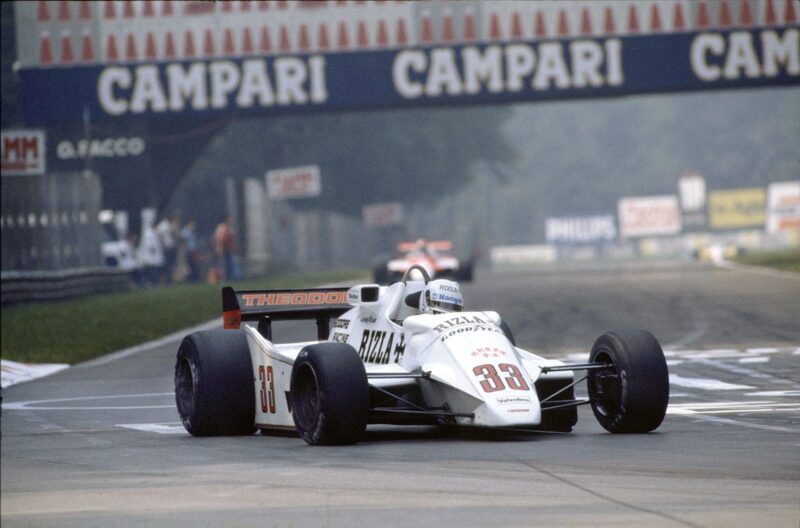
Struggling with the difficult Theodore at Monza in 1982
Motorsport Images
The two drivers couldn’t have been more different off the track, however. Senna, the rich, polished Brazilian with a superhuman work ethic; Byrne the rough-edged Irishman who thought nothing of kipping on friend’s floors and enjoyed the social side of racing.
“Senna was known as ‘fast man’. But when Firman talked of Senna as the fast man, I was like: ‘What about me, I’m fast.’ I knew he was good, he knew I was good. He didn’t like me particularly, I partied too much and he was just about business. He had the problem with me, not me with him. And he knew what would happen if he got on the track with me. I told Ralph: ‘He’s not gonna f**k with me, he might f**k with everyone else but not with me. If I’m not gonna win, he’s not gonna win’. He knew that, he would do the same to me.”
Tensions came to a head when Senna, disillusioned with his progress in Britain, announced he was retiring from the sport at the end of 1981. Firman asked Byrne – who was on his way to winning his Formula Ford 2000 titles – to drop a category and drive Senna’s car at the Formula Ford Festival. Byrne agreed and won. When Senna subsequently returned the atmosphere was frosty.
“He got all pissed off when I drove his car and won the Festival. I didn’t know anything about what was going on with his contract. I just drove the car and won the race…
“At the time he and I both had Alfasud road cars. His car was just sitting there [while Senna was in Brazil] and my car had a puncture, so I swapped the wheels because it was easier than fixing mine. He came back and starts calling me ‘f***ing Irish thief’ and all the rest, but it was nothing to do with the wheels. It was because I had won the Festival.”
The prize for the Festival win was an F3 drive with Murray Taylor Racing in the season-ending F3 race at Thruxton. Byrne made a sensational debut in the category. In his first qualifying session he was under the existing lap record and eventually came second to Dave Scott, an established front-runner who’d been doing the series all year. Taylor took him on for the 1982 season but, since Byrne was flat broke, he tried to strike a deal with McLaren boss Ron Dennis. It was to lead to an ill-fated meeting between the two men.
“Murray had the idea that if I signed a McLaren contract, giving Dennis first option on my future services, McLaren would fund the rest of my F3 season. Dennis wanted to meet me before making a decision. So off I went to Woking. I was shown into a room and there was Dennis, his partner Teddy Mayer and Tyler Alexander, one of the directors of the team. Ron did most of the talking, then started
asking questions.
“‘Where were you born?’ Dundalk. ‘What was your education?’ None. I left school at 15 and got a job. ‘What does your father do?’ Works in a factory making shoes. ‘How good are you as a driver?’ The best in the world.
“Then I popped in the question of getting money to finish the Formula 3 season. ‘All our money is tied up in R&D,’ he replied. ‘What’s R&D?’ I asked.
“You could have heard a pin drop. I knew I’d just made a bad mistake. He looked at me and in a tone you wouldn’t use on a dog, he sneered, ‘research and development’.”
It was an inauspicious introduction – and it would get worse, but in the meantime Byrne was flying: halfway through the F3 season he signed a three-year deal with the Theodore F1 team. The car was not competitive but Byrne was on the ladder – not that he endeared himself to the F1 paddock.
“In F1 nobody spoke to me. I think Niki Lauda and Nelson Piquet introduced themselves, but no one else. Keke Rosberg didn’t take a shine to me. For some reason, every time I was on the track he would give me the finger, pushing me out of the way and then in the pits afterwards, when I was sitting with the mechanics, he hit the back of the helmet and said ‘Stay the f**k out of my way’.”
Things weren’t going much better with his team. Byrne was convinced that the car was the reason he was struggling to qualify and didn’t hold back in telling his mechanics. He saw these frequent run-ins as the natural reaction of a driver trying to get the best out of his car; they saw it as a cocky F3 driver telling them how to do their jobs. Things came to a head at the last race of the season in Las Vegas.
“I scraped it onto last place on the grid. I passed Raul Boesel at the start and later got past Manfred Winkelhock, too, but I was pushing like crazy getting that Theodore to do those things and eventually, after 40 laps of it, I tagged one of the walls, damaging the suspension.
“Afterwards, back at the garage, someone said something they shouldn’t about it and I didn’t react well. I’d had it with this team of disbelieving bastards – and I told them that I wasn’t ever going to get into one of their cars again, contract or no contract. I might have thrown a chair or two. I parted by telling them to turn up at Silverstone and watch me drive the McLaren. Then they might finally understand. I wasn’t fired from F1, I told them to stick it up their arse.”
* * *
Despite missing five races while competing in F1, Byrne had still won that year’s British F3 title, the prize for which was a test drive in the McLaren F1 car at Silverstone. In many ways it would become a career-defining afternoon. Today, Byrne says he knew McLaren was not going to offer him a contract no matter how fast he was around Silverstone. But, even so, the chance to prove what he could do in one of the best cars on the grid was as good a gateway as any to the glittering world of F1.
“I actually went with a friend of mine and we took two women that we met the night before in a bar – probably not a good idea. Thierry Boutsen was in the car first and I was watching what he was doing and listening to what he said to the engineer and started to get a little worried because he was saying there was a bit of understeer and that couldn’t be fixed.
“Then when I got in the car and started driving three or four laps, there was a little bit of understeer but I just braked a little earlier and turned a little earlier and got on the gas a little earlier and there was nothing wrong. And then I was able to put my head down and wow… It was the most powerful car and the nicest car I had ever driven.
“The pit board was up there and I knew what times I was doing, but my main thought was to go faster than Thierry. Afterwards I know people said that I went faster than Lauda and John Watson and all those guys, but they were there a few days before so conditions were different. In my first stint I was quicker than Thierry – I think he did a 1min 10.9 – so anything after that was a bonus. It was just a matter of going faster and faster. I remember going through the chicane at Woodcote, which was third gear, then the next turn into Copse which was third gear. But after 10 laps, I thought to myself I was going so fast I need to go up agear so the third-gear chicane and Copse I was doing in fourth.
“You couldn’t spin the car if you tried – it was stuck to the track. I got down to a 10.6 then a 10.1 and then I thought ‘I am going to get into the nines’, and nobody had ever done a nines. Then I got called into the pits and the
test was over.”
At this point things get a little murky: in his book on Byrne’s life, Mark Hughes contends that the car Byrne was driving had its throttle artificially retarded on instructions from Tyler Alexander, who was running the test. The reason given was that the team wanted to protect the car, but the suspicion lingers that a conspiracy might have been in play to slow Byrne. Moreover, two witnesses claim that Byrne’s times were faster than those displayed on the pitwall: his last three laps were in fact 1min 9.9sec, 9.7sec and 9.6sec.
Today, Byrne is more concerned with addressing reports that at the end of the test he cockily told Alexander that the car was rubbish. “The only thing I said to Tyler Alexander – no matter what anybody says – is that, ‘I think if we put a bit more front wing on it then I could get Stowe flat.’ And he said, ‘OK, thank you Tommy,’ and that was it, all over. I wasn’t rude, that was the one time in my life I zipped my mouth because I knew it was an important test.
“After the test Motoring News ran a story that said: ‘Byrne fast but too cocky.’ It was written by Alan Henry, who was friends with Ron Dennis, so that was that. Funny thing was, Murray made us all have lunch the next week because he wanted to show Alan that I wasn’t a bad person. In the middle of lunch Alan asked me what sort of driver I thought I was and I said, ‘I think I’m a cross between Alan Prost and Gilles Villeneuve.’ He just choked and laughed at me. I guess I said the wrong thing again.”
At the same time, Byrne’s personal life was spiralling increasingly out of control. He had always enjoyed what is euphemistically called an active social life, but as his dream of F1 died, the post-race fun became darker.
“I remember the biggest night was when I had my prize for the F3 championship – this was after the McLaren test. A friend of mine gave me a big bag of cocaine and I was snorting it all day long. Niki Lauda gave me the prize and I was just all over the place. At the end of the night I couldn’t take any more and I gave it to one of my friends and he said ‘That’s not coke, it’s speed.’ And I was like, ‘It’s the same, right?’ and he said ‘No, not really…’
“After the prize-giving I was lying in bed for three days, crying. It was a severe depression brought on by drugs and it could have killed me. I was lying there in bed thinking, ‘My life is over, there’s no more Formula 1, there’s nothing to live for.’ And in reality it really was over. That was the end of my F1 dream. Three days lying in bed on a drug binge.”
* * *
Byrne’s career wasn’t quite over. In 1983 he competed in the European F3 championship for Eddie Jordan’s team, eventually finishing fourth, then again for Gary Anderson in 1984, where he finished sixth. “The idea was that a good F3 season might mean another chance at F1, but we just didn’t win the championships and the momentum was gone. I did go to a meeting with Ken Tyrrell to try once more for F1, but he was looking for £1m, which obviously I didn’t have. And by that time, really, it was done.”
It would be fair to say that Byrne’s focus had also shifted from racing to partying:
“When I knew it was all over, the lifestyle went a bit crazy. I was no different to Gerhard Berger or Eddie Irvine, but that period, 83/84, was when we had fun. I remember one time Gerhard took my clothes and threw them in the hotel swimming pool. I didn’t have any money and all my stuff had been pressed and cleaned so I was a little bit pissed off, so I went out to Gerhard’s BMW took the wheels off, took the spare wheel out, the wipers, anything I could take off and chucked it in the pool too. We were asked to leave the hotel shortly after that.”
The following year Byrne left to go to America to promote Firman’s car in the US equivalent of the Formula Ford Festival. “I went from Formula Ford to Formula 1 and then back to Formula Ford in three years – but it didn’t even faze me. I didn’t even think about it. I would drive anything. I just didn’t think about my career. Maybe if I’d had a manager it would have been different.”
From there he competed in Indy Lights, a development series for CART, and came within a whisker of winning the 1989 title, but deep down his heart wasn’t in it. “American racing was a little bit different from Europe – you can’t block or do anything dangerous. I still won a load of races, but it was just not that intense. When I was racing in Europe it was do or die. If I didn’t win my life was over, it wasn’t like that in America.” Then, in 1992 he made his fateful decision to go to Mexico.
* * *
Today, Byrne in sanguine about his rise and fall from grace. “It is what it is,” he says. Asked if he has regrets, he says: “I usually say I don’t regret anything, but I think looking back I would have done some things differently. Someone once said Tommy Byrne talked his way out of F1. And I think I would have kept my mouth shut a bit more. I remember one potential F1 sponsorship man was introduced to me. He had thick glasses and before I could think, I just said, ‘How do you see out of those fecking things?’ It was a joke, but you just don’t do that to sponsors.
“And I wish I wasn’t so naïve. I was thinking the whole time if I can just find another tenth, just one more. You have to do more than that. You need to work out more, you need to pick up the phone and call people and say ‘thank you’. You have to play the game.”
Byrne has forged a new career as a racing instructor and is married with three sons in America. Two of them are instructors like him, and his third, Cullen, 17, is an aspiring actor.
“He’s doing well and is very good, but that doesn’t mean he’ll make it. The chances are small. But I can’t tell him not to do it. I can’t tell him not to try and be an actor because then you destroy the dream, right. And you can’t do that, everyone needs to dream.”
